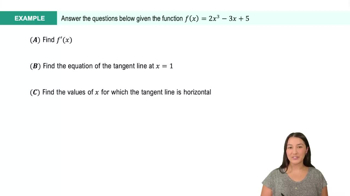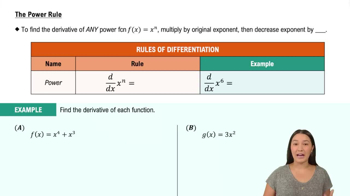Table of contents
- 0. Functions7h 52m
- Introduction to Functions16m
- Piecewise Functions10m
- Properties of Functions9m
- Common Functions1h 8m
- Transformations5m
- Combining Functions27m
- Exponent rules32m
- Exponential Functions28m
- Logarithmic Functions24m
- Properties of Logarithms34m
- Exponential & Logarithmic Equations35m
- Introduction to Trigonometric Functions38m
- Graphs of Trigonometric Functions44m
- Trigonometric Identities47m
- Inverse Trigonometric Functions48m
- 1. Limits and Continuity2h 2m
- 2. Intro to Derivatives1h 33m
- 3. Techniques of Differentiation3h 18m
- 4. Applications of Derivatives2h 38m
- 5. Graphical Applications of Derivatives6h 2m
- 6. Derivatives of Inverse, Exponential, & Logarithmic Functions2h 37m
- 7. Antiderivatives & Indefinite Integrals1h 26m
- 8. Definite Integrals4h 44m
- 9. Graphical Applications of Integrals2h 27m
- 10. Physics Applications of Integrals 2h 22m
3. Techniques of Differentiation
Basic Rules of Differentiation
Problem 39
Textbook Question
Find and simplify the derivative of the following functions.
f(x) = 3x-9
 Verified step by step guidance
Verified step by step guidance1
Step 1: Identify the function for which you need to find the derivative. Here, the function is \( f(x) = 3x^{-9} \).
Step 2: Recall the power rule for differentiation, which states that if \( f(x) = ax^n \), then \( f'(x) = anx^{n-1} \).
Step 3: Apply the power rule to the function \( f(x) = 3x^{-9} \). Here, \( a = 3 \) and \( n = -9 \).
Step 4: Differentiate the function using the power rule: \( f'(x) = 3(-9)x^{-9-1} \).
Step 5: Simplify the expression obtained in Step 4: \( f'(x) = -27x^{-10} \).
 Verified video answer for a similar problem:
Verified video answer for a similar problem:This video solution was recommended by our tutors as helpful for the problem above
Video duration:
2mPlay a video:
Was this helpful?
Key Concepts
Here are the essential concepts you must grasp in order to answer the question correctly.
Derivative
The derivative of a function measures how the function's output value changes as its input value changes. It is defined as the limit of the average rate of change of the function over an interval as the interval approaches zero. In calculus, the derivative is often denoted as f'(x) or df/dx, and it provides critical information about the function's behavior, such as its slope and points of tangency.
Recommended video:

Derivatives
Power Rule
The Power Rule is a fundamental technique for finding the derivative of functions in the form f(x) = x^n, where n is any real number. According to this rule, the derivative is given by f'(x) = n*x^(n-1). This rule simplifies the differentiation process, especially for polynomial functions, and is essential for handling terms with negative or fractional exponents.
Recommended video:
Guided course

Power Rules
Simplification of Derivatives
After finding the derivative of a function, simplification is often necessary to express the result in its most concise form. This may involve combining like terms, reducing fractions, or applying algebraic identities. Simplifying the derivative not only makes it easier to interpret but also aids in further analysis, such as finding critical points or analyzing the function's behavior.
Recommended video:

Derivatives

 3:59m
3:59mWatch next
Master Derivatives of Linear Functions with a bite sized video explanation from Callie
Start learningRelated Videos
Related Practice







